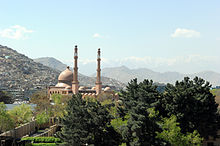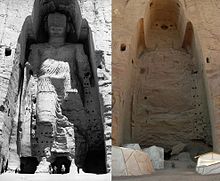You can help expand this article with text translated from the corresponding article in Persian. (March 2024) Click [show] for important translation instructions.
|
| Part of a series on the |
| Culture of Afghanistan |
|---|
 |
| History |
| People |
| Languages |
| Mythology |
| Cuisine |
| Festivals |
| Religion |
| Sport |

Afghan art has spanned many centuries. In contrast to its independence and isolation in recent centuries, ancient and medieval Afghanistan spent long periods as part of large empires, which mostly also included parts of modern Pakistan and north India, as well as Iran. Afghan cities were often sometimes among the capitals or main cities of these, as with the Kushan Empire, and later the Mughal Empire. In addition some routes of the Silk Road to and from China pass through Afghanistan, bringing influences from both the east and west.
One of the most significant periods is the Gandharan art made between the 1st and 7th centuries developing out of Greco-Buddhist art. With the arrival of Islam, later Afghanistan was for long periods part of Persianate states, and its art was often an important part of Persian art and Islamic art in general.
Since the 1900s, the nation began to use Western techniques in art. Afghanistan's art in many media was originally almost entirely done by men, although women were greatly involved in other media, but recently women are entering the arts programs at Kabul University. Art is largely centred at the National Museum of Afghanistan, the National Gallery of Afghanistan and the National Archives of Afghanistan in Kabul. There are a number of art schools in the country. The Center for Contemporary Arts Afghanistan (CCAA) in Kabul provides young people an opportunity to learn contemporary painting.

In recent decades, war and deliberate iconoclasm have caused a great amount of destruction of Afghanistan's artistic heritage.